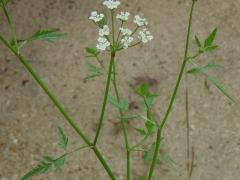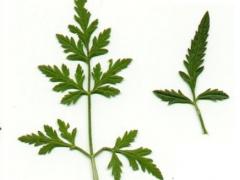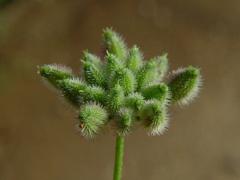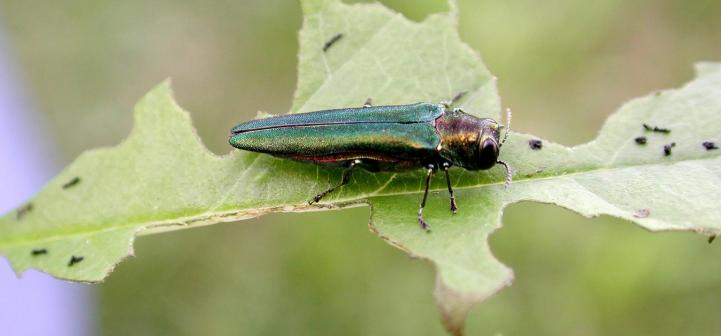Invasive Species: Torilis japonica, Japanese Hedgeparsley
Japanese hedgeparsley is a biennial herb that grows 2-4 ft. (0.6-1.2 m) tall when flowering. First-year rosettes are low, parsley-like, and green into fall. The stem leaves are alternate, fern-like, 2-5 in. (5.1-12.7 cm) long, and slightly hairy. Flowers are tiny, white, 5-petaled, and clustered in small, flat-topped umbels. Flowering occurs from June to September. The fruit are small, cylindrical, and covered with hooked hairs that attach to clothing or fur. Japanese hedgeparsley threatens woodlands and savannas. Spreading hedge parsley (T. arvensis) is very similar and invasive.
What are invasive species and why should we be concerned about them?
Taxonomy: Scientific and Common Names for This Species
Apiales > Apiaceae > Torilis japonica (Houtt.) DC.
Torilis japonica – USDA PLANTS Profile
Distribution Maps
Japanese hedgeparsley – The reported distribution of this invasive species across the United States (Source: Invasive Plant Atlas of the United States)
Up-to-the-minute distribution maps and why they are important
Reporting This Invasive Species
What is the best way and place to report the occurrence of an invasive species?
How to report an invasive species sighting to EDDMapS – Early Detection & Distribution Mapping System
EDDMapS – Report an Invasive Species to EDDMapS.
Cooperative Extension Offices – Find your local Cooperative Extension office on this map provided by USDA.
How to Identify
This invasive species can be identified by looking for the characteristics described in the paragraphs that follow.
Plant
Japanese hedgeparsley is a biennial herb that grows 2-4 ft. (0.6-1.2 m) tall when flowering.
 |
 |
| Dan Tenaglia, Missouriplants.com, bugwood.org | Dan Tenaglia, Missouriplants.com, bugwood.org |
Foliage
First-year rosettes are low, parsley-like, and green into fall. The stem leaves are alternate, fern-like, 2-5 in. (5.1-12.7 cm) long, and slightly hairy.
 |
 |
| Dan Tenaglia, Missouriplants.com, bugwood.org | Dan Tenaglia, Missouriplants.com, bugwood.org |
Flower
Flowers are tiny, white, 5-petaled, and clustered in small, flat-topped umbels. Flowering occurs from June to September.
 |
 |
| Dan Tenaglia, Missouriplants.com, bugwood.org | Dan Tenaglia, Missouriplants.com, bugwood.org |
Fruit
The fruit are small, cylindrical, and covered with hooked hairs that attach to clothing or fur.
 |
 |
| Dan Tenaglia, Missouriplants.com, bugwood.org | Dan Tenaglia, Missouriplants.com, bugwood.org |
Native Species That Can Resemble Japanese Hedgeparsley
– Images at invasive.org
| bugwood.org | bugwood.org |
– Images at invasive.org
| bugwood.org | bugwood.org |
Additional Images for Japanese Hedgeparsley
Japanese hedgeparsley – Images at Invasive.org
Learning Resources for Japanese Hedgeparsley
Video: Identification of Invasive Species – University of Wisconsin-Cooperative Extension Service
Additional Information, Biology, Control and Management Resources
Control and management recommendations vary according to individual circumstances. Location, habitat, weather, and a variety of other conditions are factors that help determine the best treatment choice. To find the safest and most effective treatment for your situation, consult your state’s land-grant institution. If you will use chemicals as part of the control process, always refer to the product label.
United States Land-Grant University System – Find your land-grant university’s college of agriculture, Cooperative Extension office, or other related partner on this map provided by USDA.
Invasive Plants of the United States – Invasive.org
Robert W. Freckmann Herbarium – University of Wisconsin – Stevens Point
Invasive Plants of Wisconsin – University of Wisconsin – Green Bay
New Invasive Plants of the Midwest Fact Sheet – MIPN.org
Invasive species – Wisconsin Department of Natural Resources
Invasive species – MinnesotaWildflower
